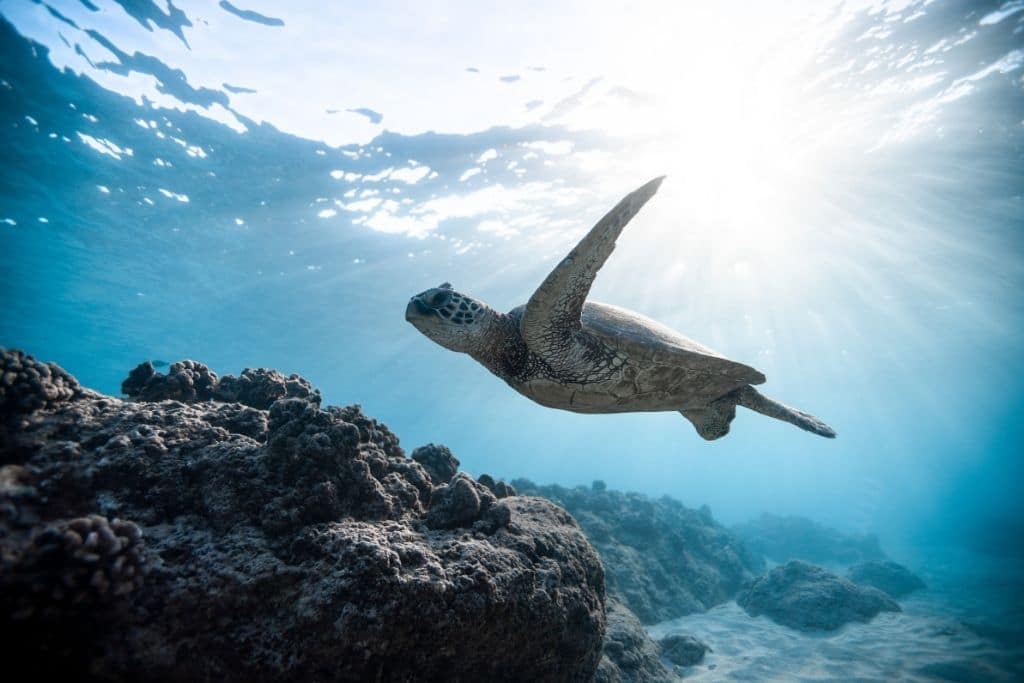World Sea Turtle Day is celebrated every year on June 16 to raise awareness about the plight of sea turtles. Of the seven species of sea turtle found all over the world, six of them are classified as either threatened or endangered. Several factors are responsible for sea turtle species being endangered and placing them in such a vulnerable state, chief among which are the impacts of climate change and human activity.
—
Green, Hawksbill, Kemp’s Ridley, Leatherback, Loggerhead, and Olive Ridley sea turtles are the six species that are currently threatened and endangered, and can be found in every ocean except the Arctic and Antarctic. Recent estimates place the total number of sea turtles in the wild at 6.5 million across all species, although there is variance from one to the next. Some species like the Kemp’s Ridley could have populations less than 10,000, making them critically endangered. The only exception to this is the Flatback sea turtle, which resides in the waters around Australia and is classified as data deficient, meaning there is not enough information available to make a declaration of their conservation status. As marine creatures, they live within vast areas of the open seas where they feed, but they also habitually return to land in order to lay eggs and reproduce. Some will travel as far 6,000km back and forth each way, committing to a long journey in order to continue the life cycle of their species.
Moreover, sea turtles play an important role in maintaining the ecosystem of the world’s oceans. By grazing on seagrass beds and sea sponges within coral reefs, they prevent overgrowth which in turn improves current flows, nitrogen production, and promotes the healthy cultivation of flora and fauna. Some sea turtles also prey upon jellyfish and crustaceans, keeping their population numbers under control. They also provide sustenance for other fish since barnacles, algae, and small organisms can cling to their shells, supporting a robust food web. These positive feedback loops and the recycling of nutrients are vital for marine habitats, and due to their migratory lifestyles, sea turtles can transport nitrogen, phosphorus, and potassium from the oceans to the beaches they nest upon.
Yet despite this, sea turtles are threatened by several factors which have led to declining populations. Climate change poses specific challenges such as harsher storms, rising sea levels, hotter sands, and shifting currents. Sea turtles depend upon beaches and coastlines for their reproduction cycles, and storms like hurricanes or cyclones, or the gradual rise in sea levels due to melting ice caps would cause erosion and flooding of these regions. Additionally, hotter sands and increasing regional temperatures can disproportionately impact the biological sex of sea turtle hatchlings, thereby lowering genetic diversity when it comes to reproduction. Finally, changes in the patterns of ocean currents directly affects the migration routes of sea turtles, which can drive them away from feeding grounds, altering their mating and nesting times, and exposing them to more risks from human activity.
You might also like: Shortage of Male Sea Turtles in Florida as Temperatures Reach Record High
On that matter, coastal development, ocean pollution, and overfishing all present greater harm to vulnerable and endangered sea turtle species. Urban sprawl and the encroachment of human settlements directly affects sea turtles by reducing the amount of viable land where they can lay their eggs. Artificial light sources from buildings have been known to confuse and misdirect new hatchlings, leading them away from the water where they are meant to go and deeper inland, succumbing to exhaustion, predation, and collisions with automobiles. On the other hand, trash, chemicals, plastics, and other pollutants produced by human activity are often discarded on beaches or in the ocean, causing illness and injury to sea turtles when they accidentally consume the waste or get tangled up in it. Aside from that, fishing practices and the presence of commercial boats are known to cause fatalities to sea turtles when they are caught in nets and fishing lines, or when they are struck by passing boats.
Counter to these threats, however, there are cases to be made for human intervention on behalf of sea turtles. The Seychelles atoll, found within the Indian Ocean, has seen a surge in Green sea turtle numbers since the species was declared as protected there in 1968. Prior to then, they were hunted and exploited to near extinction by traders for over a century. Yet with conservation efforts and close monitoring by the Seychelles Islands Foundation, the Green sea turtle population residing near the atoll is back on the rise, increasing as much as 500% over the lows of the 1960s.
There are many other organisations based around the world, all of which are dedicated to protecting endangered sea turtle species as well as promoting the cause of marine stewardship. Some of their work includes coastal clean-up projects and recycling programmes to reduce the amount of harmful pollution, establishing protected areas and habitats on beaches or at sea, and enforcing maritime laws and agreements that regulate fishing practices. On an individual level, concerned activists can enact local engagement with these types of initiatives, and no act alone is too small when every little bit counts.
All in all, the sea turtle is a noble creature deserving of greater respect and dignity, but the ravages of climate change and the harms of human activity have endangered the survival of their species. Even so, it is not too late to reverse the declines in their population, and there is much more that can still be done to save the turtles.
You might also like: The Implications of Global Warming For Sea Turtle Management and Survival


















